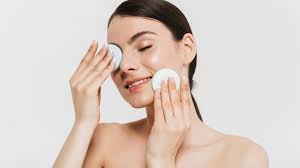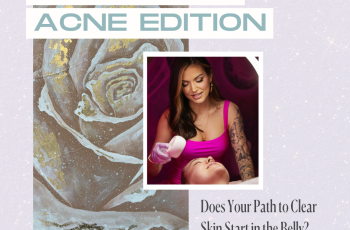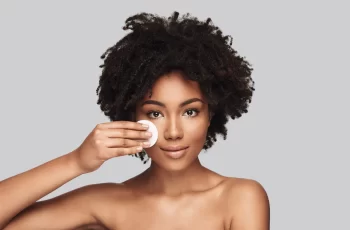Can I Use Niacinamide to Help Treat My Acne?
Niacinamide, also known as vitamin B3, has rapidly gained popularity in the skincare world, often seen as an essential part of many TikTok skincare routines. Its fame is well-deserved, given its impressive range of benefits for the skin. Known for its ability to brighten dark spots, reduce redness, and even out skin tone, niacinamide is a versatile ingredient that many swear by.
But what about its potential for treating acne? Is it as effective for acne-prone skin as it is for general skin concerns like hyperpigmentation or fine lines? We asked board-certified dermatologists, Dr. Marisa Garshick and Dr. Jessie Cheung, to weigh in on whether niacinamide can help manage and treat acne.
What Is Niacinamide?
Niacinamide, or vitamin B3, is a water-soluble vitamin known for its wide array of benefits for the skin. Dr. Garshick explains, “Niacinamide is a versatile ingredient that can target several skin concerns, such as redness and discoloration, all while being gentle on the skin.”
One of its most significant benefits is its ability to boost ceramide production. Ceramides are lipids that help maintain the skin’s barrier function, which is essential for keeping the skin hydrated and protected from environmental stressors like UV rays and pollution. Additionally, niacinamide has anti-inflammatory properties that can soothe redness and irritation, making it a great option for those with sensitive skin or skin conditions like eczema and rosacea.
Does Niacinamide Work for Acne?
Yes, niacinamide can certainly help with acne. Dr. Cheung points out that niacinamide works by balancing oil production in the skin, which is crucial for preventing clogged pores—one of the primary causes of acne. It also helps reduce the appearance of pores, which can become enlarged due to excess oil and acne breakouts.
Dr. Garshick adds that niacinamide can also improve the appearance of hyperpigmentation and dark spots left behind by acne lesions. These post-acne marks can be one of the most stubborn and frustrating aspects of acne, but niacinamide’s brightening effects can help fade them over time.
In short, niacinamide tackles acne by addressing multiple factors: it reduces inflammation, helps control oil production, and fades scars—all key components in acne treatment.
How to Add Niacinamide to Your Skincare Routine
If you’re considering adding niacinamide to your skincare routine to help with acne, here are a few expert tips to keep in mind:
1. Patch Test First
As with any new ingredient, it’s important to patch test before applying niacinamide to your entire face. To do this, apply a small amount of the product on a small area of skin, like the inside of your wrist or behind your ear. Wait 24-48 hours to see if any irritation or allergic reaction occurs. This will help you determine if niacinamide is suitable for your skin.
2. Start with a Lower Concentration
Dr. Cheung recommends starting with a lower concentration of niacinamide, especially if you have sensitive skin. A concentration of 2-5% is typically well-tolerated by most people, and even higher concentrations (up to 10%) can be used if your skin shows no signs of irritation. Starting small allows you to gauge how your skin responds to the ingredient.
3. Choose the Right Product
Niacinamide is available in various skincare products, including serums, toners, moisturizers, and even spot treatments. When selecting a product, consider your skin type and the specific skin concerns you’re trying to address. For example, if you have oily, acne-prone skin, a niacinamide serum may be ideal for controlling excess oil and reducing pore size. On the other hand, a moisturizer with niacinamide might be a great choice if you’re concerned with both hydration and acne treatment.
4. Don’t Overdo It
When it comes to niacinamide, more is not necessarily better. Overuse of the ingredient can lead to irritation or sensitivity, especially in higher concentrations. Stick to the recommended usage instructions on your product and allow time for niacinamide to work its magic.
5. Be Patient
Like most skincare ingredients, niacinamide takes time to show visible results. You may not notice a dramatic difference overnight, so consistency is key. It may take a few weeks for you to see noticeable changes in your acne, hyperpigmentation, or skin tone.
Recommended Niacinamide Products for Acne-Prone Skin
If you’re looking to incorporate niacinamide into your routine, Dr. Garshick recommends a few products that have worked well for acne-prone skin:
TruSkin Niacinamide Serum: This serum is effective at improving discoloration and brightening the skin without being greasy or irritating.
MaeLove’s NIA 10 Serum: Especially great for those with sensitive, dry, or acne-prone skin, this calming serum combines niacinamide with other soothing ingredients like zinc and white tea extract.
ISDIN Melaclear Advanced: This product combines niacinamide with tranexamic acid and licorice root extract to treat dark spots, including those caused by acne or melasma.
These products are formulated to be gentle yet effective, helping to address acne while improving the overall appearance of the skin.
Potential Side Effects and Precautions
While niacinamide is generally considered safe for most people, it’s still important to be mindful of how it interacts with other ingredients in your skincare routine. Dr. Cheung advises that niacinamide should not be applied at the same time as AHAs (alpha hydroxy acids) or BHAs (beta hydroxy acids), as the high pH of niacinamide can interfere with the absorption of these acids. However, niacinamide pairs well with other ingredients, such as kojic acid, arbutin, or tranexamic acid, which can enhance its brightening effects.
Niacinamide is typically well-tolerated, but in higher concentrations (above 10%), it may cause irritation or sensitivity in some individuals. Always pay attention to how your skin feels, and if irritation occurs, reduce the concentration or frequency of use.
The Final Takeaway
Niacinamide is a powerhouse ingredient that can be very effective in treating acne. It helps balance oil production, reduces inflammation, minimizes the appearance of pores, and fades post-acne marks—all of which are important for managing acne-prone skin. Whether you’re dealing with active breakouts or acne scars, niacinamide offers a gentle yet powerful solution.
If you’re considering adding niacinamide to your skincare routine, follow the guidelines provided by dermatologists, start slowly, and be patient. With consistent use, you may begin to see significant improvements in the health and appearance of your acne-prone skin. With its brightening, soothing, and protective properties, niacinamide is an ingredient that can truly make a difference for those struggling with acne.
DQH Knowledge drop: In your 20s, your skin cell turnover decreases. (Cell turnover is a key component in keeping your skin youthful.) You know what else slows down? Your collagen production. Starting in your 20s, collagen decreases by about 1 percent per year. Should you want to prevent fine lines and wrinkles, start by eliminating behaviors that contribute to premature aging. “If it’s bad for you, it’s bad for your skin,” says dermatologist Michel Somenek.
“Cigarette smoking reduces blood flow to the skin and causes premature wrinkling and a dull skin texture. Making the repeated pursed motion to inhale can also cause smoker’s lines. Alcohol and recreational drugs are toxins for the skin that damage its cellular structure and DNA,” Somenek tells us. “The faster you eliminate vices while you are young, the better chance your skin and body have to recuperate.” Also, adopting an anti-aging routine in your 20s is key. After all, the best offense is a good defense. We spoke to Somenek and experts Joshua Ross and Audrey Kunin to find out more.
Keep reading for the best anti-aging products for your 20s, according to skincare professionals.
Sunscreen
“We all know that the sun is the number one cause of skin aging and starting the prevention in your 20s is very important,” Ross says. “The majority of your sun damage won’t start to appear until you’re in your 30s, so don’t wait until you see it surface or you’ll be behind the curve. Stay ahead of it with a good-quality zinc-based sunscreen worn daily.”
Farmacy Green Defense Daily Mineral Sunscreen
An invisible sunscreen with SPF 30, plus botanical extracts meant to protect skin with tons of antioxidants. Bonus: It’s clean and fine to use under makeup.
Bareminerals Complexion Rescue™ Tinted Moisturizer Broad Spectrum SPF 30
Although we recommend you use your SPF and moisturizer separately, we also understand moments when you don’t have time or energy for that extra step. For those times, this bareMinerals moisturizer is a great thing to have on hand.
Vitamin C Serum
“A great introduction to anti-aging is to start with a vitamin C serum in your morning skincare routine,” Ross says. “It’s a powerful antioxidant that will neutralize free radicals and brighten the skin.” He adds that it’s a great way to counteract the effects of the sun’s harmful rays, which, as previously mentioned, are among the biggest causes of premature aging.
Drunk Elephant C-Firma™ Vitamin C Day Serum
The Drunk Elephant C-Firma is a lightweight serum that promises to give skin a glow by combining the brightening powers of vitamin C with ferulic acid, l-ascorbic acid, and vitamin E. The included sodium hyaluronate is meant to replace hydration loss, so you shouldn’t have to deal with any irritation.
Sunday Riley C.E.O. Rapid Flash Brightening Serum
This potent serum is jam-packed with vitamin C (15 percent, to be exact), which means it’s a potential superstar at both brightening skin and dousing it in antioxidants.
Peptides
Using peptides on your skin has many benefits, says Somenek. “The skin barrier is what defends the body against pollution, UV rays, bacteria, and toxins. It can be damaged by several everyday factors. Using topical peptides aids in building a stronger barrier,” he says. “Peptides comprise elastic fibers, which are a type of protein. These fibers help to make skin appear taut and firm. Peptides can also help repair damaged skin, relieve inflammation, and even out skin tone. Some peptides can kill acne-causing bacteria that is common in 20-somethings.”
Kunin agrees, saying, “Peptides are an excellent entry point for supporting collagen.” She recommends looking for face and eye treatments that contain these collagen-boosting powerhouses.
Charlotte Tilbury Magic Eye Rescue Cream
This Charlotte Tilbury super-emollient eye cream has a base of coconut oil and shea butter (read: it’s incredibly hydrating). Botanicals plus peptides are meant to help reduce dark circles and boost collagen, respectively.
This creamy moisturizer serves up potent collagen-boosting peptides and pycnogenol, and antioxidant-rich vitamin C. “Instead of sitting on top of the skin, peptides penetrate the outer layer so they go deep. The ‘signals’ they send tell the cells to produce elastin and collagen, which are needed for youthful-looking skin,” explains Somenek.
At-Home Peel Pads
Remember that skin cell turnover fiasco we talked about earlier? One way to help support it is by exfoliating. “Exfoliation is important to help keep skin fresh and luminous,” Kunin says. She recommends using at-home peel pads as an easy and effective way to exfoliate.
“The goal in your 20s is to fight the slowing pace of cell turnover. It is wise to use products that gently exfoliate, yet still remove oil and other impurities. Products that have Alpha Hydroxy Acids (AHA) or Beta Hydroxy Acids (BHA) are a good choice.”
According to Somenek, you should only exfoliate two to three times a week. “People of all ages are guilty of over-exfoliating and that can be too much of a good thing,” he says.
Dermadoctor Kakadu C Intensive Vitamin C Peel Pad
A few swipes of this Derma Doctor powerful peel pad promise to leave your skin glowing and smooth, thanks to the seven (yes, seven) types of chemical exfoliants, including AHA and BHA. It also contains vitamin C via Kakadu plum extract for added brightening and antioxidant protection.
KEY INGREDIENTS Kakadu plum extract is sourced from the Kakadu plum, a fruit grown in northern Australia. It contains vitamin C, which restores the skin’s natural barrier, increases collagen production, and soothes irritation.
Dr. Dennis Gross Skincare Alpha Beta® Universal Daily Peel Pads
These are the gold standard of peel pads, with a cult following and over 900 five-star reviews on Sephora. They’re easy to use and contain a blend of anti-aging exfoliating acids.
Emollient Night Cream
“In your 20s, you need to start upping the hydration in your skincare routine. You may have been cautious of over-moisturizing because of acne in your teens, but as you enter your 20s, your skin transitions and becomes drier,” Ross says. “I recommend an emollient night cream added into your evening skincare regimen.”
“Twenty-somethings need to make sure that they are not using creams that will clog their pores and cause excess oil production,” says Somenek. Opt for non-comedogenic products.
Cerave Skin Renewing Night Cream
One great choice is the CeraVe Skin Renewing Night Cream, which is a non-comedogenic night cream that leaves skin soft and glowy. It combines the moisturizing powers of ceramides and hyaluronic acid.
RoC Retinol Correxion Max Hydration Creme
“The best night cream ingredients contain retinol, benzoyl peroxide, and/or salicylic acid or hyaluronic acid. The goal is to moisturize, yet remove excess oil,” says Somenek. This Roc Retinol Correxion cream fits the bill as it contains both hyaluronic acid and retinol so it promises to moisturize while also being non-comedogenic.



